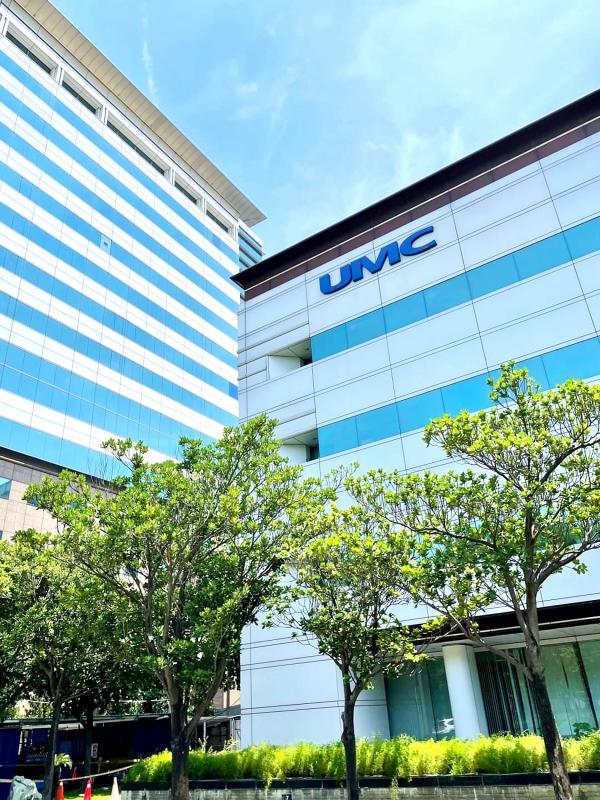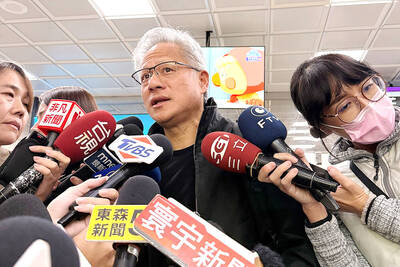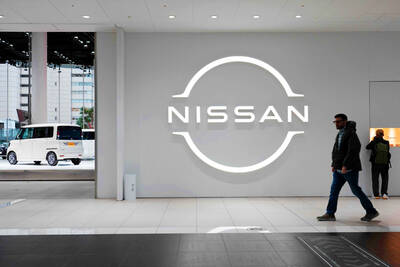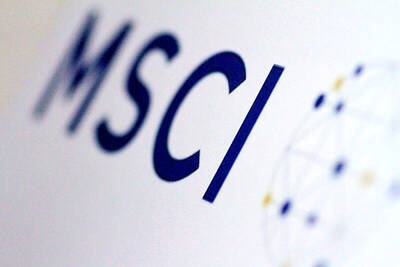Contract chipmaker United Microelectronics Corp (UMC, 聯電) yesterday raised its capital spending plan for this year by more than 66 percent to US$3 billion to expand capacity, including 28-nanometer chips, as customer demand continued to outpace supply.
It expects the investment to boost capacity by 6 percent from last year.
UMC spent US$1.8 billion on new manufacturing equipment and facilities last year, about US$500 million less than its original estimate due to delays in equipment delivery.

Photo: Grace Hung, Taipei Times
“We believe that current semiconductor mega trends — continuing penetration of 5G phones, acceleration of electric vehicle adoption and proliferation of AIoT devices [artificial intelligence of things] — will continue to drive higher demand for silicon content,” UMC co-president Jason Wang (王石) told investors via a teleconference.
“That will lead to higher demand for foundry capacity and technologies not only for leading nodes, but also for UMC’s focus markets in the foreseeable future,” he said.
As Chinese chipmakers are also expanding 28-nanometer capacity, Wang said that an oversupply could set in in 2023, but it would be mild and short, as more applications gradually migrate to 28-nanometer chips from older-generation technologies.
The company has signed long-term supply agreements with customers, with 80 percent of 28-nanometer chips covered by those agreements, Wang said.
UMC’s revenue growth is forecast to match or even outpace the foundry industry’s 20 percent growth this year, he said.
That was an upward revision from a prior estimate of 12 percent growth for foundry.
The chipmaker attributed the revenue growth to annual price hikes of about 15 percent, a similar increase for last year amid a lingering chip crunch.
However, UMC expects surges in labor and raw material costs to offset most benefits from wafer price increases this year, suggesting little room for more gross margin growth.
Factory utilization would remain 100 percent this quarter, it said.
This quarter, gross margin is expected to rise to about 40 percent, from 39.1 percent in the previous quarter, UMC said.
The increase is much slower than a 5 percent uptick quarter-on-quarter in blended average selling prices for this quarter.
Net profit expanded 42.5 percent to NT$15.95 billion last quarter from NT$11.2 billion. That translated into earnings per share (EPS) of NT$1.3, up from NT$0.92 a year earlier.
UMC’s net profit last year soared 91 percent to NT$55.78 billion, from NT$29.29 billion in 2020. EPS rose to NT$4.57 from NT$2.42.
Revenue expanded 20.5 percent to NT$213.01 billion from NT$176.82 billion in 2020.
UMC said that 28-nanometer chips, the biggest revenue contributor last year, accounted for 20 percent of the total last year, up from 14 percent in 2020.

PERSISTENT RUMORS: Nvidia’s CEO said the firm is not in talks to sell AI chips to China, but he would welcome a change in US policy barring the activity Nvidia Corp CEO Jensen Huang (黃仁勳) said his company is not in discussions to sell its Blackwell artificial intelligence (AI) chips to Chinese firms, waving off speculation it is trying to engineer a return to the world’s largest semiconductor market. Huang, who arrived in Taiwan yesterday ahead of meetings with longtime partner Taiwan Semiconductor Manufacturing Co (TSMC, 台積電), took the opportunity to clarify recent comments about the US-China AI race. The Nvidia head caused a stir in an interview this week with the Financial Times, in which he was quoted as saying “China will win” the AI race. Huang yesterday said

Nissan Motor Co has agreed to sell its global headquarters in Yokohama for ¥97 billion (US$630 million) to a group sponsored by Taiwanese autoparts maker Minth Group (敏實集團), as the struggling automaker seeks to shore up its financial position. The acquisition is led by a special purchase company managed by KJR Management Ltd, a Japanese real-estate unit of private equity giant KKR & Co, people familiar with the matter said. KJR said it would act as asset manager together with Mizuho Real Estate Management Co. Nissan is undergoing a broad cost-cutting campaign by eliminating jobs and shuttering plants as it grapples

The Chinese government has issued guidance requiring new data center projects that have received any state funds to only use domestically made artificial intelligence (AI) chips, two sources familiar with the matter told Reuters. In recent weeks, Chinese regulatory authorities have ordered such data centers that are less than 30 percent complete to remove all installed foreign chips, or cancel plans to purchase them, while projects in a more advanced stage would be decided on a case-by-case basis, the sources said. The move could represent one of China’s most aggressive steps yet to eliminate foreign technology from its critical infrastructure amid a

MORE WEIGHT: The national weighting was raised in one index while holding steady in two others, while several companies rose or fell in prominence MSCI Inc, a global index provider, has raised Taiwan’s weighting in one of its major indices and left the country’s weighting unchanged in two other indices after a regular index review. In a statement released on Thursday, MSCI said it has upgraded Taiwan’s weighting in the MSCI All-Country World Index by 0.02 percentage points to 2.25 percent, while maintaining the weighting in the MSCI Emerging Markets Index, the most closely watched by foreign institutional investors, at 20.46 percent. Additionally, the index provider has left Taiwan’s weighting in the MSCI All-Country Asia ex-Japan Index unchanged at 23.15 percent. The latest index adjustments are to